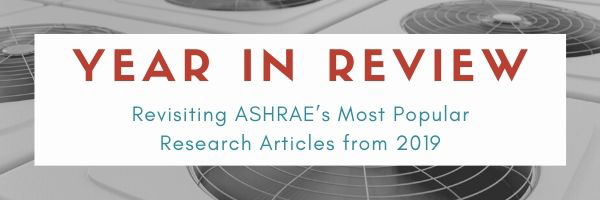
Control Sequence Simulating Multi-Zone HVAC Systems in Direct Digital Control Systems Tops List
From eSociety, December 2019
From the impact of HVAC system filters on IAQ to simulating multi-zone HVAC systems in direct digital control systems, this year’s ASHRAE research articles ran the gamut on how building systems can increase efficiency to help occupants.
Catch up on the most read ASHRAE research articles that appeared in this year’s eSociety newsletters. Here are the top five articles in ascending order.
5. Assessing Demand Response Potential in Small Commercial Buildings
From October’s eSociety
Researchers assessed building demand responsive control strategies in a variety of commercial building types, climates and utility rate structures. Jie Cai, Associate Member ASHRAE, discusses the study featured in Science and Technology for the Built Environment that can help identify effective and economical solutions to mitigate the adverse impact of renewables and to improve the grid operational efficiency. Read more
(Tie) 4. Analyzing the Use of CO2 as a Refrigerant in Vertical DX Geothermal Evaporators
From October’s eSociety
To increase the use of ground source heat pumps, researchers are proposing using natural refrigerants in direct expansion. A Science and Technology for the Built Environment article explores theoretical and experimental investigations on a single U-tube vertical direct expansion borehole heat exchanger using CO2 as the refrigerant. One researchers, Messaoud Badache, Ph.D., discusses the research. Read more
(Tie) 4. Using Two Modeling Approaches to Analyze Heat Transfer Processes
From May’s eSociety
An article appearing in the May/June edition of Science and Technology for the Built Environment analyzes the heat transfer processes of a ground heat exchanger (GHE) system when adopting two computational fluid dynamics (CFD) modeling approaches. Wenxin Li with the National Centre for International Research of Low-Carbon and Green Buildings at Chongqing University, explains the article’s significance and challenges. Read more
3. Developing More Credible Building Performance Measurements
From August’s eSociety
Measuring building performance can be difficult, impractical and complex at the intermediate and advanced levels. So, ASHRAE researchers analyzed ASHRAE 2010 Performance Measurement Protocols for Commercial Buildings. Liping Wang, Ph.D., P.E., Member ASHRAE, discusses the research that assessed the validity, reliability and practicality of the PMP. Read more
2. Assessing HVAC System Filters' Impact on IAQ
From March’s eSociety
Using filters in HVAC systems is one way to reduce exposure to airborne particulate matter in residential buildings, which can lead to health risks for building occupants. In a recent Science and Technology for the Built Environment article, Masih Alavy and Jeffrey Siegel, Ph.D., Fellow ASHRAE, present an integrated picture of the overall performance of higher efficiency residential filters by assessing the impacts of their use in residences that incorporate a forced air recirculating HVAC system. Read more
1. Control Sequence Simulates Multizone HVAC Systems in Direct Digital Control Systems
From August’s eSociety
Engineers have been struggling with using demand control ventilation as required by ANSI/ASHRAE/IES Standard 90.1 and also still complying with the ventilation requirements in ANSI/ASHRAE Standard 62.1. ASHRAE Research Project 1747 developed a practical, programmable control sequence to simulate the energy and ventilation performance in several buildings with multiple zone HVAC systems. C. Hwakong Cheng, P.E., Member ASHRAE discusses the research. Read more